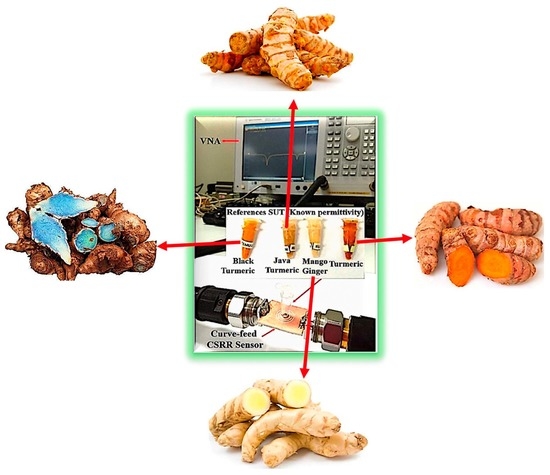Detection of Semi-Solid Materials Utilizing Triple-Rings CSRR Microwave Sensor
Abstract
:1. Introduction
2. Triple-Rings CSRR Design and Validation
2.1. Sensor Design Configuration
2.2. Parametric Study on Triple-Rings CSRR Microwave Sensor
2.3. Analysing of the Sample under Tests (SUTs)
2.3.1. Effect of Polypropylene (PP) Based Triple-Rings Sensor
2.3.2. Simulation of Semi-Solid Materials under Test
3. Fabrication, Measurement and Characterizations
3.1. Curve-Feed Sensor Fabrication
3.2. Semi-Solid Sample under Measurements
3.3. Sensitivity
4. Conclusions
Author Contributions
Funding
Institutional Review Board Statement
Informed Consent Statement
Data Availability Statement
Conflicts of Interest
References
- Lisovsky, V.V. Automatic control of moisture in agricultural products by methods of microwave aquametry. Meas. Sci. Technol. 2007, 18, 1016–1021. [Google Scholar] [CrossRef]
- Jónasson, S.Þ.; Jensen, B.S.; Johansen, T.K. Study of split-ring resonators for use on a phar-maceutical drug capsule for microwave activated drug release. In Proceedings of the 2012 42nd European Microwave Conference, Amsterdam, The Netherlands, 29 October 2012–1 November 2012; IEEE: Piscataway, NJ, USA, 2012. [Google Scholar]
- Tiuri, M. Microwave sensor applications in industry. In Proceedings of the 1987 17th European Microwave Conference, Rome, Italy, 7–11 September 1987; IEEE: Piscataway, NJ, USA, 1987. [Google Scholar]
- Wang, C.; Ali, L.; Meng, F.-Y.; Adhikari, K.K.; Zhou, Z.L.; Wei, Y.C.; Zou, D.Q.; Yu, H. High-Accuracy Complex Permittivity Characterization of Solid Materials Using Parallel Interdigital Capacitor- Based Planar Microwave Sensor. IEEE Sens. J. 2021, 21, 6083–6093. [Google Scholar] [CrossRef]
- Xiang, Y.; Huang, J.; Fu, L.; Chen, Y.; Gu, W.; Wu, Y. A Folded Substrate Integrated Waveguide Re-Entrant Cavity for Full Characterization of Magneto-Dielectric Powder Materials. IEEE Sens. J. 2021, 21, 10657–10666. [Google Scholar] [CrossRef]
- Li, Z.; Meng, Z.; Soutis, C.; Wang, P.; Gibson, A. Detection and analysis of metallic contaminants in dry foods using a microwave resonator sensor. Food Control. 2022, 133, 108634. [Google Scholar] [CrossRef]
- Bobowski, J.S.; Clements, A.P. Permittivity and Conductivity Measured Using a Novel Toroidal Split-Ring Resonator. IEEE Trans. Microw. Theory Tech. 2017, 65, 2132–2138. [Google Scholar] [CrossRef] [Green Version]
- Yeh, C.-H.; Yang, C.-H. Material characterization for Zircaloy claddings in elevated temperatures using a laser ultrasound technique. In Proceedings of the 2012 IEEE International Ultrasonics Symposium, Dresden, Germany, 7–10 October 2012; pp. 265–268. [Google Scholar] [CrossRef]
- Allouti, N.; Chausse, P.; Aumont, C.; Isselé, H.; Vignoud, L.; Rochat, N.; Poulain, C.; Gasiglia, M.; Sourd, C.; Argoud, M.; et al. Photo-dielectric polymers material characterizations for 3D packaging applications. In Proceedings of the 2013 IEEE 15th Electronics Packaging Technology Conference (EPTC 2013), Singapore, 11–13 December 2013; pp. 27–32. [Google Scholar] [CrossRef]
- Gao, R.; Yu, W.; Deng, H.; Ku, H.S.; Li, Z.; Wang, M.; Miao, X.; Lin, Y.; Deng, C. Epitaxial titanium nitride microwave resonators: Structural, chemical, electrical, and microwave proper-ties. Phys. Rev. Mater. 2022, 6, 036202. [Google Scholar] [CrossRef]
- Chernousov, Y.D.; Ivannikov, V.I.; Shebolaev, I.V.; Bolotov, V.A.; Tanashev, Y.Y.; Parmon, V.N. Characteristics of a chemical reactor that is a loaded microwave resonator. J. Commun. Technol. Electron. 2009, 54, 231–233. [Google Scholar] [CrossRef]
- Lodi, M.B.; Curreli, N.; Melis, A.; Garau, E.; Fanari, F.; Fedeli, A.; Randazzo, A.; Mazzarella, G.; Fanti, A. Microwave Characterization and Modeling of the Carasau Bread Doughs During Leavening. IEEE Access 2021, 9, 159833–159847. [Google Scholar] [CrossRef]
- Eremenko, Z.E.; Ganapolskii, E.M.; Vasilchenko, V.V. Exact-calculated resonator method for permittivity measure-ment of high loss liquids at millimetre wavelength. Meas. Sci. Technol. 2005, 16, 1619. [Google Scholar] [CrossRef]
- Morales-Lovera, H.-N.; Olvera-Cervantes, J.-L.; Perez-Ramos, A.-E.; Corona-Chavez, A.; Saavedra, C.E. Microstrip sensor and methodology for the determination of complex anisotropic permittivity using perturbation techniques. Sci. Rep. 2022, 12, 2205. [Google Scholar] [CrossRef]
- Cordoba-Erazo, M.F.; Weller, T.M. Low-cost non-contact microwave probe design for insulating materials characterization. In Proceedings of the 78th ARFTG Microwave Measurement Conference, Tempe, AZ, USA, 1–2 December 2011; pp. 1–5. [Google Scholar] [CrossRef]
- Morozov, O.G.; Nasybullin, A.R.; Danilaev, M.P.; Farkhutdinov, R.V. Sensor applications of Bragg microwave structures realized in coaxial waveguide. In Proceedings of the 2015 International Conference on Antenna Theory and Techniques (ICATT), Kharkiv, Ukraine, 21–24 April 2015; pp. 1–3. [Google Scholar] [CrossRef]
- Yuan, Z.; Wang, J.; Zhang, J.; Li, E.; Li, Y. Measurement of optical signal by Microwave Coaxial resonator. In Proceedings of the 2021 IEEE MTT-S International Microwave Workshop Series on Advanced Materials and Processes for RF and THz Applications (IMWS-AMP), Chongqing, China, 15–17 November 2021; pp. 130–132. [Google Scholar] [CrossRef]
- Mondal, D.; Tiwari, N.K.; Akhtar, M.J. Microwave Assisted Non-Invasive Microfluidic Biosensor for Monitoring Glucose Concentration. In Proceedings of the 2018 IEEE SENSORS, New Delhi, India, 28–31 October 2018; pp. 1–4. [Google Scholar] [CrossRef]
- Kulkarni, S.; Joshi, M.S. Design and Analysis of Shielded Vertically Stacked Ring Resonator as Complex Permittivity Sensor for Petroleum Oils. IEEE Trans. Microw. Theory Tech. 2015, 63, 2411–2417. [Google Scholar] [CrossRef]
- Hamzah, H.; Abduljabar, A.; Lees, J.; Porch, A. A Compact Microwave Microfluidic Sensor Using a Re-Entrant Cavity. Sensors 2018, 18, 910. [Google Scholar] [CrossRef] [Green Version]
- Ye, W.; Zhao, W.-S.; Wang, J.; Wang, D.-W.; Wang, G. A Split-Ring Resonator-Based Planar Microwave Sensor for Microfluidic Applications. In Proceedings of the 2022 IEEE MTT-S International Microwave Biomedical Conference (IMBioC), Suzhou, China, 16–18 May 2022; pp. 34–36. [Google Scholar] [CrossRef]
- Mukherjee, S.; Shi, X.; Udpa, L.; Udpa, S.; Deng, Y.; Chahal, P. Design of a Split-Ring Resonator Sensor for Near-Field Microwave Imaging. IEEE Sens. J. 2018, 18, 7066–7076. [Google Scholar] [CrossRef]
- Kundal, S.; Khandelwal, A. Highly sensitive ring resonator based refractive index sensor for label free biosensing applications. In Proceedings of the 2022 International Conference on Numerical Simulation of Optoelectronic Devices (NUSOD), Turin, Italy, 12–16 September 2022; pp. 157–158. [Google Scholar] [CrossRef]
- Bari, R.T.B.; Haque, E.; Rahman, T.; Faruque, O. Improved Design of a Ring Resonator Based Notch Filter with High Quality Factor and Sensitivity. In Proceedings of the 2022 IEEE IAS Global Conference on Emerging Technologies (GlobConET), Arad, Romania, 20–22 May 2022; pp. 406–410. [Google Scholar] [CrossRef]
- Abdolrazzaghi, M.; Daneshmand, M.; Iyer, A.K. Strongly Enhanced Sensitivity in Planar Microwave Sensors Based on Metamaterial Coupling. IEEE Trans. Microw. Theory Tech. 2018, 66, 1843–1855. [Google Scholar] [CrossRef] [Green Version]
- Abdolrazzaghi, M.; Katchinskiy, N.; Elezzabi, A.Y.; Light, P.E.; Daneshmand, M. Noninvasive glucose sensing in aque-ous solutions using an active split-ring resonator. IEEE Sens. J. 2021, 21, 18742–18755. [Google Scholar] [CrossRef]
- Chudpooti, N.; Silavwe, E.; Akkaraekthalin, P.; Robertson, I.D.; Somjit, N. Nano-Fluidic Millimeter-Wave Lab-on-a-Waveguide Sensor for Liquid-Mixture Characterization. IEEE Sens. J. 2018, 18, 157–164. [Google Scholar] [CrossRef] [Green Version]
- Bahar, A.A.M.; Zakaria, Z.; Ab Rashid, S.R.; Isa, A.A.M.; Alahnomi, R.A. Dielectric analysis of liquid solvents using microwave resonator sensor for high efficiency measurement. Microw. Opt. Technol. Lett. 2016, 59, 367–371. [Google Scholar] [CrossRef]
- Withayachumnankul, W.; Jaruwongrungsee, K.; Tuantranont, A.; Fumeaux, C.; Abbott, D. Metamaterial-based microflu-idic sensor for dielectric characterization. Sens. Actuators A: Phys. 2013, 189, 233–237. [Google Scholar] [CrossRef] [Green Version]
- Kiani, S.; Rezaei, P.; Navaei, M. Dual-sensing and dual-frequency microwave SRR sensor for liquid samples permittivity detection. Measurement 2020, 160, 107805. [Google Scholar] [CrossRef]
- Su, L.; Munoz-Enano, J.; Velez, P.; Martel, J.; Medina, F.; Martin, F. On the Modeling of Microstrip Lines Loaded with Dumbbell Defect-Ground-Structure (DB-DGS) and Folded DB-DGS Resonators. IEEE Access 2021, 9, 150878–150888. [Google Scholar] [CrossRef]
- Kandwal, A.; Nie, Z.; Igbe, T.; Li, J.; Liu, Y.; Liu, L.W.; Hao, Y. Surface Plasmonic Feature Microwave Sensor with Highly Confined Fields for Aqueous-Glucose and Blood-Glucose Measurements. IEEE Trans. Instrum. Meas. 2021, 70, 1–9. [Google Scholar] [CrossRef]
- Al-Gburi, A.J.A.; Zakaria, Z.; Ibrahim, I.M.; Aswir, R.S.; Alam, S. Solid Characterization Utilizing Planar Micro-wave Resonator Sensor. ACES J. 2022, 37, 222–228. [Google Scholar]
- Staszek, K.; Piekarz, I.; Sorocki, J.; Koryciak, S.; Wincza, K.; Gruszczynski, S. Low-Cost Microwave Vector System for Liquid Properties Monitoring. IEEE Trans. Ind. Electron. 2017, 65, 1665–1674. [Google Scholar] [CrossRef]
- Rahman, N.A.; Zakaria, Z.; Rahim, R.A.; Alahnomi, R.A.; Al-Gburi, A.J.A.; Alhegazi, A.; Rashid, W.N.A.; Bahar, A.A.M. Liquid Permittivity Sensing Using Teeth Gear-Circular Substrate Integrated Waveguide. IEEE Sens. J. 2022, 22, 11690–11697. [Google Scholar] [CrossRef]
- Alhegazi, A.; Zakaria, Z.; Shairi, N.A.; Kamarudin, M.R.; Alahnomi, R.A.; Azize, A.; Wan Hassan, W.H.; Bahar, A.; Al-Gburi, A.J.A. Novel Technique of Gap Waveguide Cavity Resonator Sensor with High Resolution for Liquid Detection. Int. J. Antennas Propag. 2022, 2022, 2401586. [Google Scholar] [CrossRef]
- Ansari, M.A.H.; Jha, A.K.; Akhtar, M.J. Design and Application of the CSRR-Based Planar Sensor for Noninvasive Measurement of Complex Permittivity. IEEE Sens. J. 2015, 15, 7181–7189. [Google Scholar] [CrossRef]
- Daniel, R.S.; Pandeeswari, R.; Raghavan, S. Multiband monopole antenna loaded with Complementary Split Ring Resonator and C-shaped slots. AEU Int. J. Electron. Commun. 2017, 75, 8–14. [Google Scholar] [CrossRef]
- EasyRF, 2013, Split Ring Resonator (SRR) Calculator [Online]. Available online: https://srrcalculator.blogspot.com/p/calculator.html (accessed on 10 December 2022).
- Khandelwal, M.K.; Kanaujia, B.K.; Kumar, S. Defected Ground Structure: Fundamentals, Analysis, and Applications in Modern Wireless Trends. Int. J. Antennas Propag. 2017, 2017, 1–22. [Google Scholar] [CrossRef]
- Aziz, N.A.A.; Malaysia, U.P.; Hassan, J.; Abbas, Z.; Osman, N.H. Microwave Dielectric Properties of Four Types of Rhizomes from Zingiberaceace Family. J. Phys. Sci. 2017, 28, 15–26. [Google Scholar] [CrossRef] [Green Version]
- Haq, T.; Koziel, S. Rapid Design Optimization and Calibration of Microwave Sensors Based on Equivalent Complementary Resonators for High Sensitivity and Low Fabrication Tolerance. Sensors 2023, 23, 1044. [Google Scholar] [CrossRef]
- Karimi, F. Properties of the Drying of Agricultural Products in Microwave Vacuum: A Review Article. J. Agric. Technoloty 2010, 6, 269–287. [Google Scholar]
- Racoti, A.; Buttress, A.J.; Binner, E.; Dodds, C.; Trifan, A.; Calinescu, I. Microwave assisted hydro-distillation of essential oils from fresh ginger root (Zingiber officinale Roscoe). J. Essent. Oil Res. 2017, 29, 471–480. [Google Scholar] [CrossRef]
- Jafari, F.S.; Ahmadi-Shokouh, J. Reconfigurable microwave SIW sensor based on PBG structure for high accuracy per-mittivity characterization of industrial liquids. Sens. Actuators A Phys. 2018, 283, 386–395. [Google Scholar] [CrossRef]
- Armghan, A.; Alanazi, T.M.; Altaf, A.; Haq, T. Characterization of Dielectric Substrates Using Dual Band Microwave Sensor. IEEE Access 2021, 9, 62779–62787. [Google Scholar] [CrossRef]
- Velez, P.; Grenier, K.; Mata-Contreras, J.; Dubuc, D.; Martin, F. Highly-Sensitive Microwave Sensors Based on Open Complementary Split Ring Resonators (OCSRRs) for Dielectric Characterization and Solute Concentration Measurement in Liquids. IEEE Access 2018, 6, 48324–48338. [Google Scholar] [CrossRef]
- Wang, C.; Liu, X.; Huang, Z.; Yu, S.; Yang, X.; Shang, X. A Sensor for Characterisation of Liquid Materials with High Permittivity and High Dielectric Loss. Sensors 2022, 22, 1764. [Google Scholar] [CrossRef]
- Shahzad, W.; Hu, W.; Ali, Q.; Raza, H.; Abbas, S.M.; Ligthart, L.P. A Low-Cost Metamaterial Sensor Based on DS-CSRR for Material Characterization Applications. Sensors 2022, 22, 2000. [Google Scholar] [CrossRef]
- Han, X.; Zhou, Y.; Li, X.; Ma, Z.; Qiao, L.; Fu, C.; Peng, P. Microfluidic Microwave Sensor Loaded with Star-Slotted Patch for Edible Oil Quality Inspection. Sensors 2022, 22, 6410. [Google Scholar] [CrossRef] [PubMed]
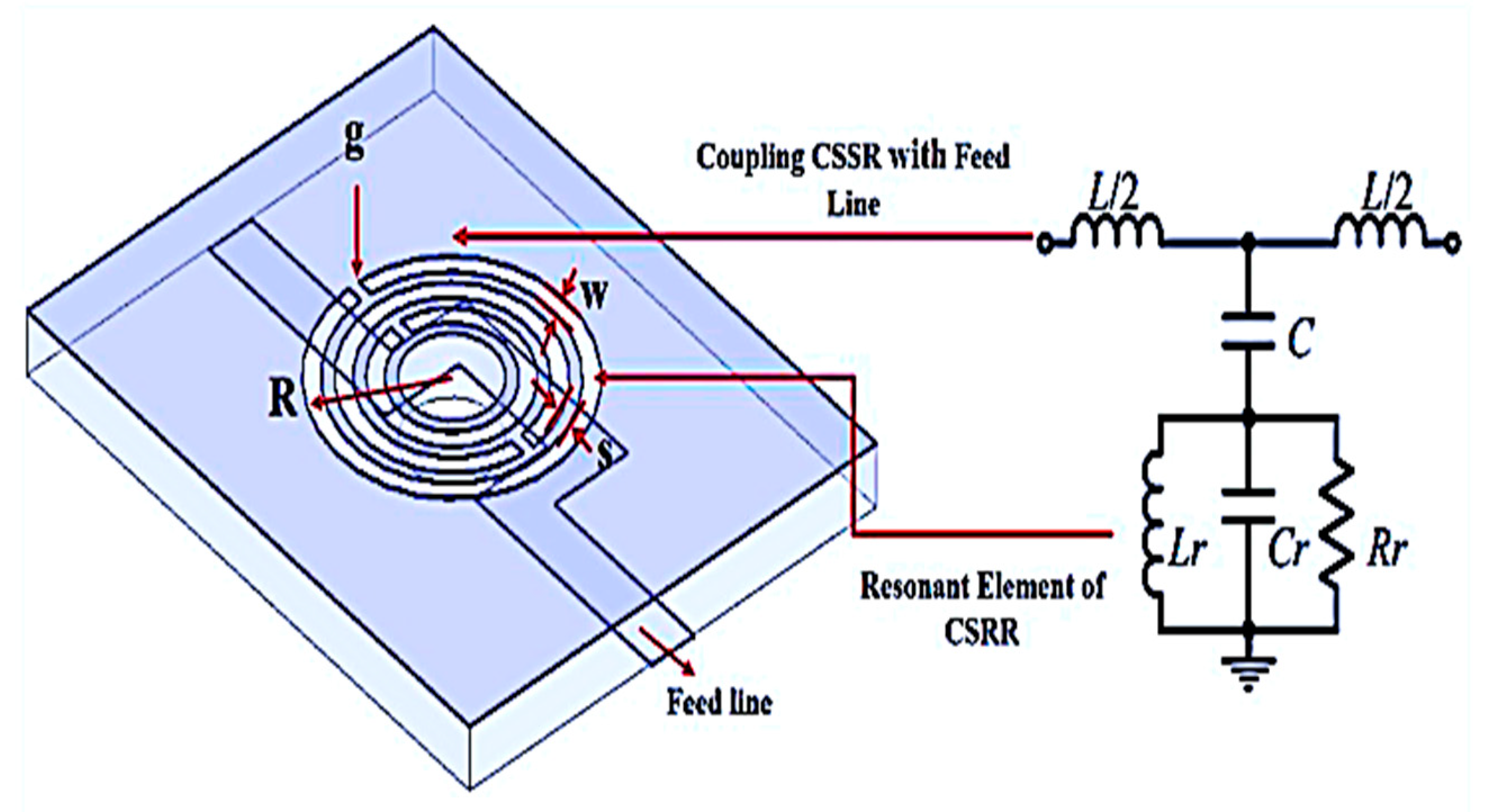

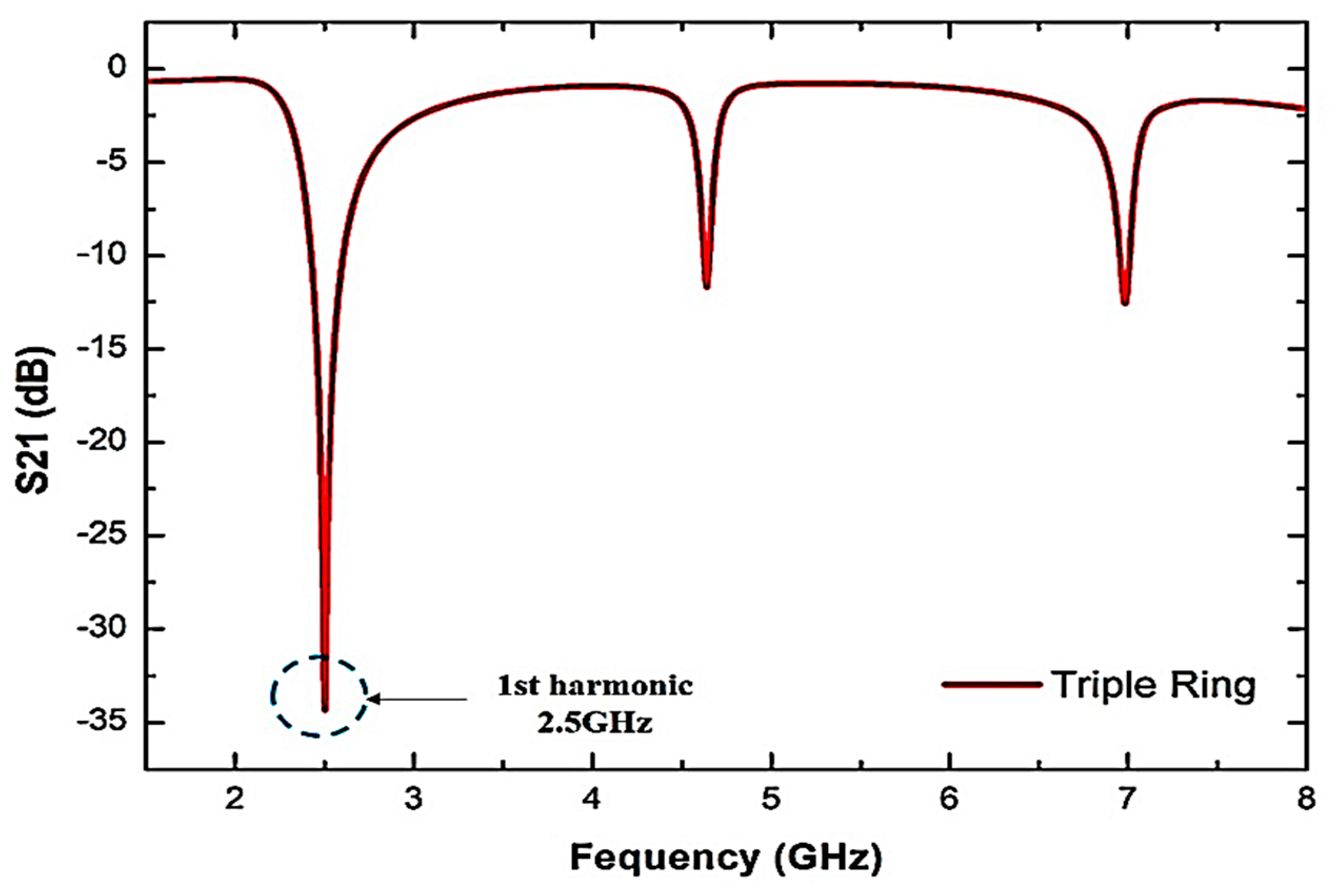
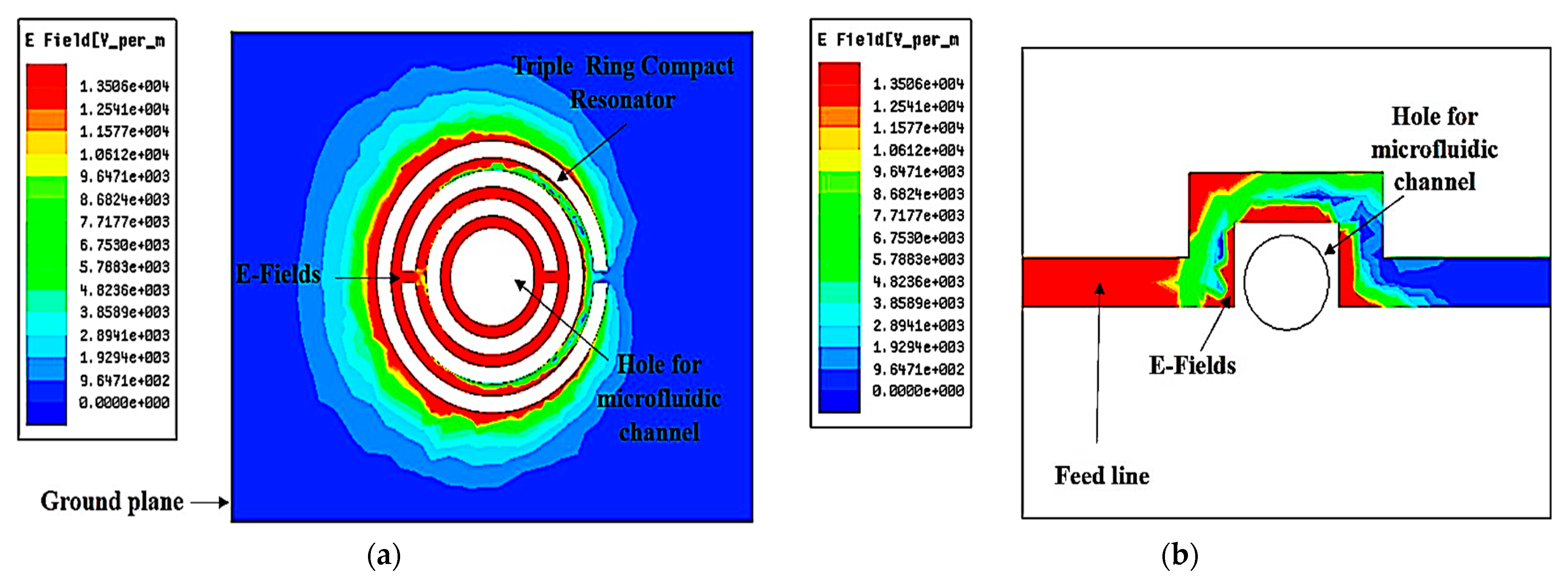
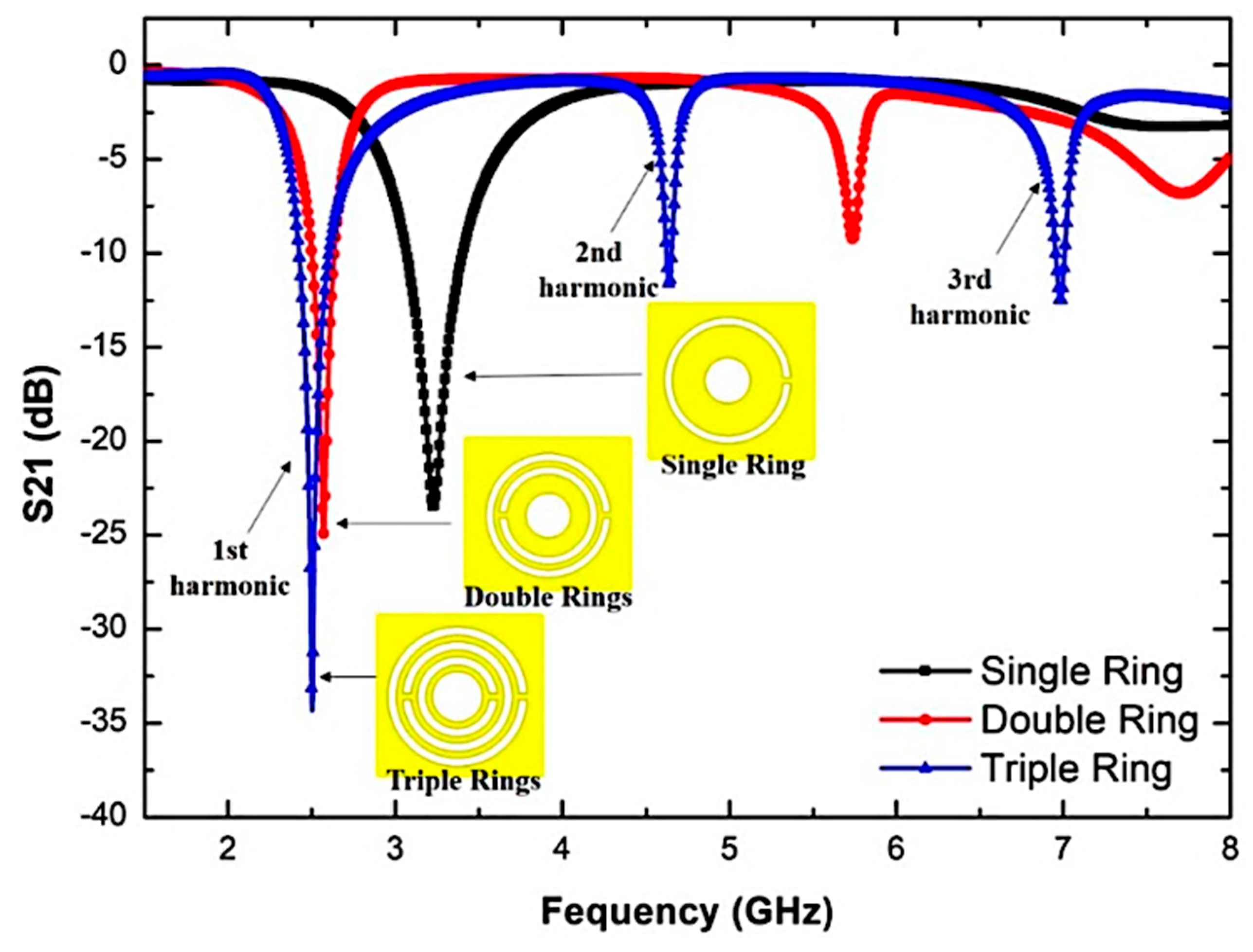


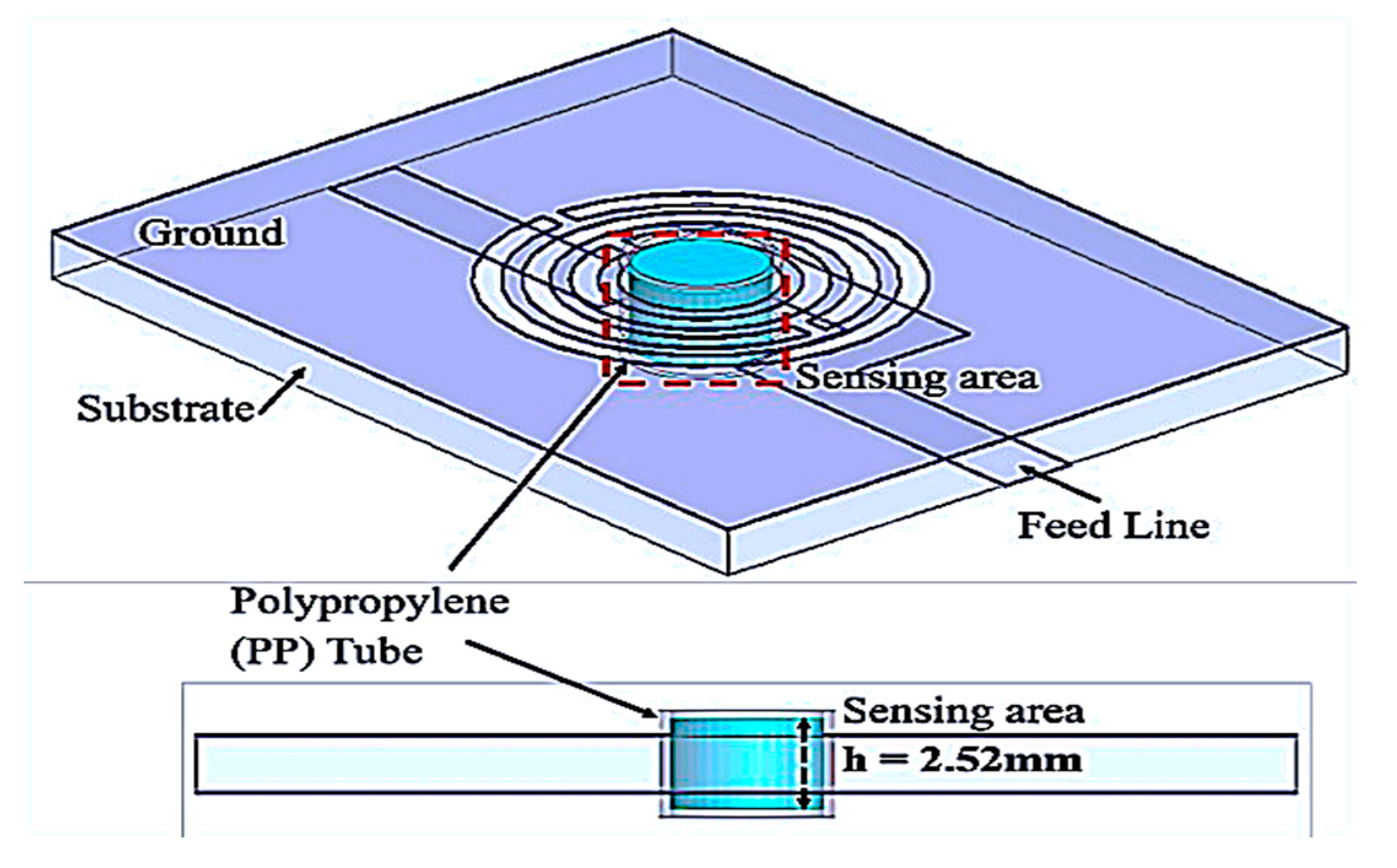
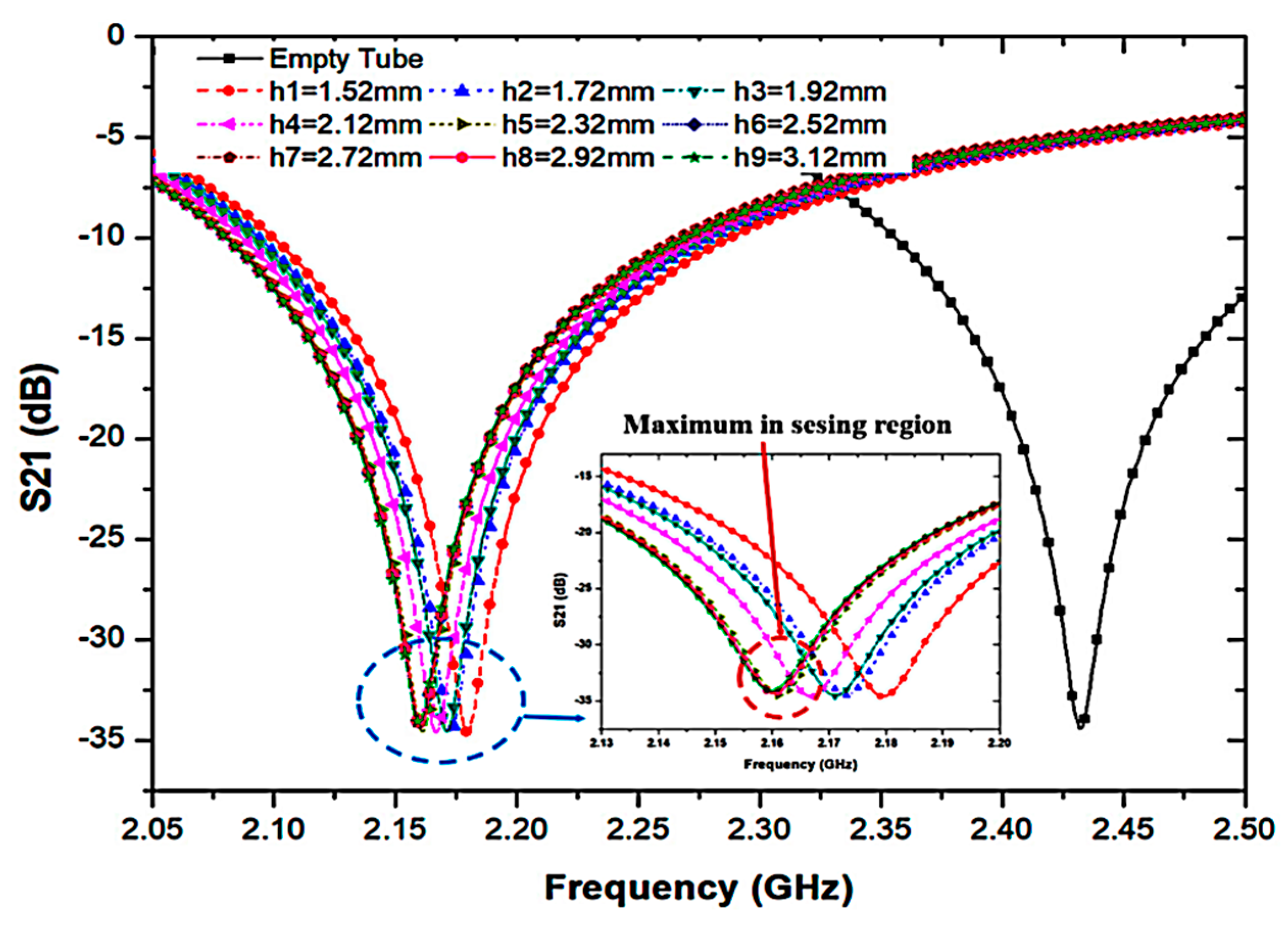
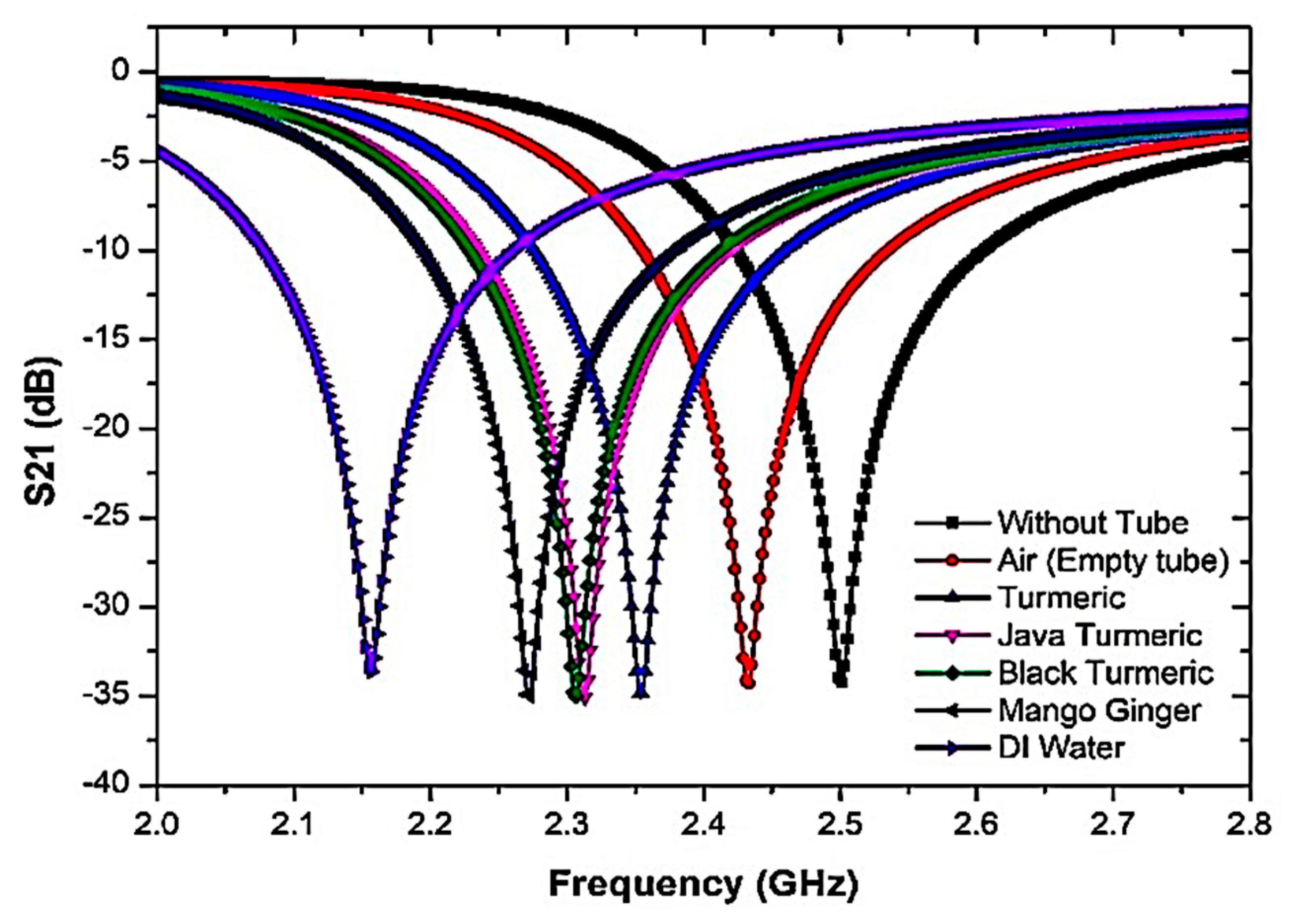
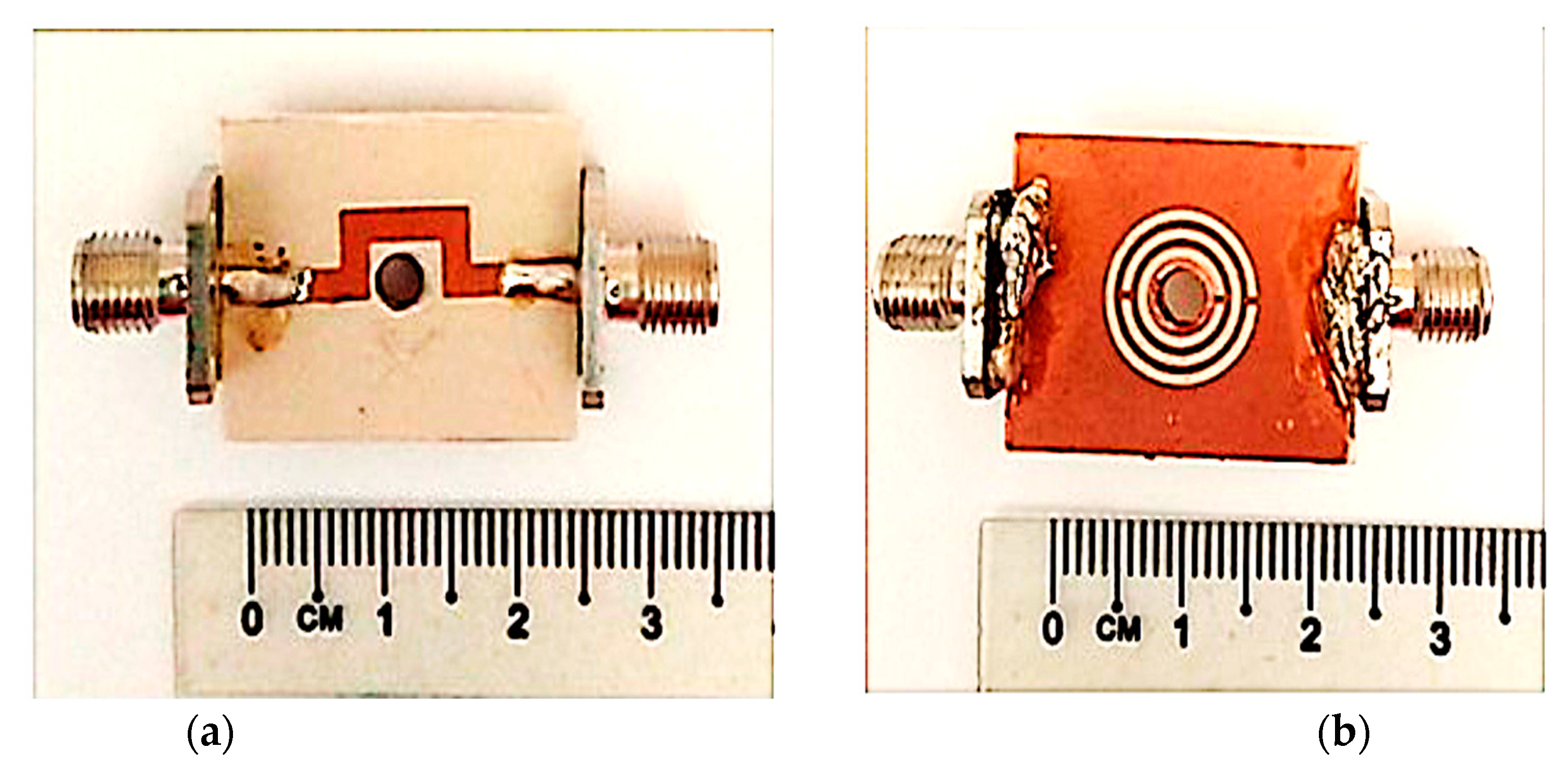

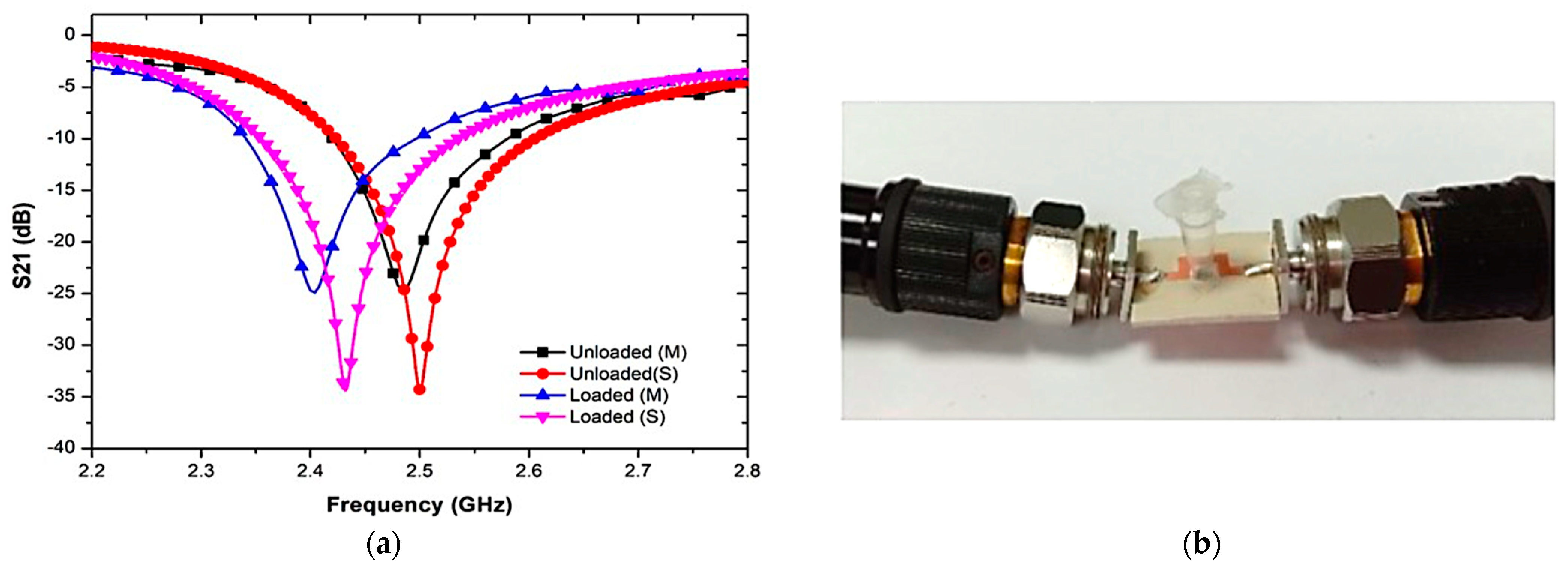







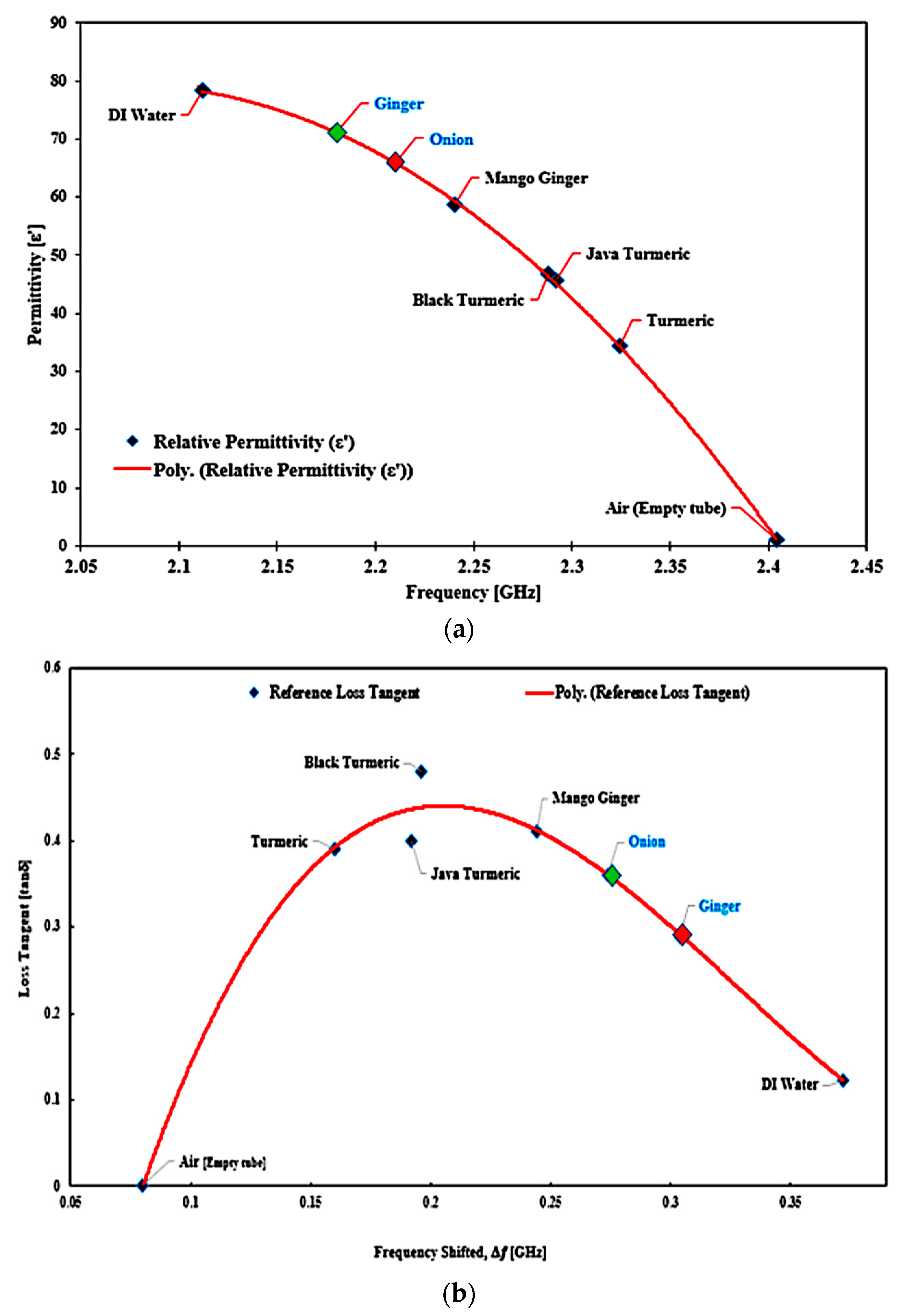
| Parameters | L | W | FL | FW | RH | RW | Rg | Rs | R1 | R2 | R3 |
|---|---|---|---|---|---|---|---|---|---|---|---|
| Values (mm) | 25 | 20 | 28 | 2.1 | 2 | 0.68 | 0.5 | 0.5 | 5.54 | 3.18 | 3.18 |
| CSRR | Frequency (GHz) | Q-Factor | Insertion Loss, 𝑺21 (dB) | Electric Fields (v/m) |
|---|---|---|---|---|
| Single Ring | 3.23 | 91 | −23.476 | 9.8 × 103 |
| Double Ring | 2.57 | 220 | −24.949 | 1.33 × 104 |
| Triple Ring | 2.5 | 520 | −34.281 | 1.55 × 104 |
| SUTs | Frequency (GHz) | S21 (dB) | Frequency Shifted (MHz) |
|---|---|---|---|
| Without tube | 2.5 | −34.2808 | 0 |
| Air (empty tube) | 2.432 | −34.3829 | 68 |
| Turmeric | 2.354 | −35.0751 | 146 |
| Java Turmeric | 2.313 | −35.1014 | 187 |
| Black Turmeric | 2.306 | −35.1009 | 194 |
| Mango Ginger | 2.272 | −35.1594 | 228 |
| DI Water | 2.16 | −33.6507 | 340 |
| SUTs | Q-Factor | Simulation | Measurement | ||
|---|---|---|---|---|---|
| Frequency (GHz) | S21 (dB) | Frequency (GHz) | S21 (dB) | ||
| Unloaded | 520 | 2.5 | −34.281 | 2.484 | −24.799 |
| Loaded | 230 | 2.432 | −34.3829 | 2.404 | −29.9078 |
| SUTs | Top Sensor | Bottom Sensor | ||
|---|---|---|---|---|
| Frequency (GHz) | S21 (dB) | Frequency (GHz) | S21 (dB) | |
| Air (Empty tube) | 2.404 | −24.9078 | 2.404 | −23.0683 |
| Turmeric | 2.324 | −11.9063 | 2.324 | −13.8716 |
| Java Turmeric | 2.292 | −11.3478 | 2.292 | −11.9612 |
| Black Turmeric | 2.288 | −11.4268 | 2.288 | −13.7979 |
| Mango Ginger | 2.24 | −11.6293 | 2.24 | −13.5679 |
| DI Water | 2.112 | −13.0072 | 2.112 | −15.0731 |
| SUTs | Relative Permittivity (εr) | Simulation | Measurement | ||
|---|---|---|---|---|---|
| Frequency (GHz) | S21 (dB) | Frequency (GHz) | S21 (dB) | ||
| Air (Empty tube) | 1.0006 | 2.423 | −34.0156 | 2.404 | −24.9078 |
| Turmeric | 34.52 | 2.354 | −35.0751 | 2.324 | −11.9063 |
| Java Turmeric | 45.6 | 2.313 | −35.1014 | 2.292 | −11.3478 |
| Black Turmeric | 46.68 | 2.306 | −35.1009 | 2.288 | −11.4268 |
| Mango Ginger | 58.61 | 2.272 | −35.1594 | 2.24 | −11.6293 |
| DI Water | 78.4 | 2.16 | −33.6507 | 2.112 | −13.0072 |
| SUTs | Frequency Shifting (GHz) | Reference Relative Permittivity | Proposed Sensor | * Commercial Sensor | ||
|---|---|---|---|---|---|---|
| Relative Permittivity (ε’) | Error (%) | Relative Permittivity (ε’) | Error (%) | |||
| Air (Empty tube) | 2.404 | 1.0006 | 1.006 | 10.03 | 1.0093 | 0.969 |
| Turmeric | 2.324 | 34.52 | 34.317 | 0.59 | 52.43 | 51.88 |
| Java Turmeric | 2.292 | 45.6 | 45.047 | 1.21 | 54.60 | 19.74 |
| Black Turmeric | 2.288 | 46.68 | 46.285 | 0.85 | 48.74 | 4.41 |
| Mango Ginger | 2.24 | 58.61 | 59.366 | 1.29 | 41.28 | 29.57 |
| DI Water | 2.112 | 78.4 | 78.177 | 0.28 | 81.19 | 3.56 |
| Average Error | 2.38% | 18.34% | ||||
| SUTs | Frequency Shifting (Δf) | Reference Ideal Loss Tangent | Proposed Sensor | * Commercial Sensor | ||
|---|---|---|---|---|---|---|
| Loss Tangent (tan δ) | Error (%) | Loss Tangent (tan δ) | Error (%) | |||
| Air (Empty tube) | 0.08 | 0 | 0.0004 | 0 | 0.0001 | 0 |
| Turmeric | 0.16 | 0.39 | 0.3915 | 0.38 | 0.253 | 35.135 |
| Java Turmeric | 0.192 | 0.4 | 0.4366 | 9.15 | 0.252 | 36.905 |
| Black Turmeric | 0.196 | 0.48 | 0.4387 | 8.6 | 0.261 | 45.615 |
| Mango Ginger | 0.244 | 0.41 | 0.4138 | 0.93 | 0.383 | 6.702 |
| DI Water | 0.372 | 0.123 | 0.1229 | 0.08 | 0.197 | 45.43 |
| Average Error | 4% | 28.3% | ||||
| SUTs | f (GHz) | Δf (GHz) | Reference | Calculated | ||||
|---|---|---|---|---|---|---|---|---|
| ε′ | tan δ | ε″ | ε′ | tan δ | ε″ | |||
| Air (Empty tube) | 2.404 | 0.08 | 1.0006 | 0 | 0 | 2.83 | 0.0004 | 0.0008 |
| Turmeric | 2.324 | 0.16 | 43.52 | 0.39 | 13.46 | 34.64 | 0.3915 | 12.5616 |
| Java Turmeric | 2.292 | 0.192 | 45.6 | 0.4 | 18.24 | 45.191 | 0.4366 | 19.7304 |
| Black Turmeric | 2.288 | 0.196 | 46.68 | 0.48 | 22.41 | 46.411 | 0.4387 | 20.3605 |
| Mango Ginger | 2.24 | 0.244 | 58.61 | 0.41 | 24.03 | 59.324 | 0.438 | 24.5483 |
| Onion | 2.21 | 0.274 | 64 | 0.218 | 14 | 65.781 | 0.3622 | 23.8259 |
| Ginger | 2.18 | 0.304 | 71.42 | 0.199 | 14.23 | 70.996 | 0.2936 | 20.8444 |
| DI Water | 2.112 | 0.372 | 78.4 | 0.123 | 9.64 | 78.222 | 0.1229 | 9.6135 |
| SUTs | Frequency (GHz) | Δf (MHz) | εr | Δεr | S [MHz/εr] |
|---|---|---|---|---|---|
| Air (Empty tube) | 2.404 | 80 | 1.0006 | 0 | 0 |
| Turmeric | 2.324 | 160 | 34.52 | 33.519 | 4.773 |
| Java Turmeric | 2.292 | 192 | 45.6 | 44.599 | 4.305 |
| Black Turmeric | 2.288 | 196 | 46.68 | 45.679 | 4.291 |
| Mango Ginger | 2.24 | 244 | 58.61 | 57.609 | 4.235 |
| DI Water | 2.112 | 372 | 78.4 | 77.399 | 4.806 |
| # | References | Sensors Sizes (mm) | Used Techniques | SUTs Samples | Frequency Band (GHz) | Q-Factor | Sensitivity (S) |
|---|---|---|---|---|---|---|---|
| 1 | [25] | 80 × 40 × 0.8 | Metamaterial coupling | Liquid | 2.5 | Not reported | 0.27 |
| 2 | [26] | 80 × 25 × 0.8 | Loss-compensated SRR | Glucose | 1.156 | 190 | Not reported |
| 3 | [27] | 26 × 30 × 26.5 | Waveguide with loop slot | Liquid | 91 | Not reported | Not reported |
| 4 | [28] | 112.96 × 49.16 × 3.175 | Multiple split-ring resonator | Liquid | 2.1 | 525 | Not reported |
| 5 | [33] | 40 × 50 × 0.79 | Two arms SRR | Solid | 2.27 | 240 | Not reported |
| 6 | [36] | 38 × 35.4 × 15.73 | GWCR | Liquid | 5.96 | 66.8 | 0.156 |
| 7 | [45] | 25 × 30 × 1.54 | CCSR | Liquid | 2.4 | Not reported | Not reported |
| 8 | [46] | 30 × 25 × 1.6 | CSSRRs | AIR, HDPE and PVC | 5.35 and 7.99 | 267.5 | 0.04 |
| 9 | [47] | 46 × 46 × 1.6 | OCSRRs | Liquid | 0.9 | Not reported | 4.3 |
| 10 | [48] | 28 × 20 × 0.75 | CSRR | Liquid | 2.85 and 2.96 | 145 | 3.0 |
| 11 | [49] | 24 × 60 × 1.6 | DS-SRR | Coal | 4.75 | Not reported | Not reported |
| 12 | [50] | 70 × 70 × 1.6 | Star-Slotted Patch | Oil | 2.68 | 37.36 | 1.87 |
| This work | 25 × 20 × 1.52 | Triple-rings CSRR | Semi-solid | 2.5 | 520 | 4.806 | |
Disclaimer/Publisher’s Note: The statements, opinions and data contained in all publications are solely those of the individual author(s) and contributor(s) and not of MDPI and/or the editor(s). MDPI and/or the editor(s) disclaim responsibility for any injury to people or property resulting from any ideas, methods, instructions or products referred to in the content. |
© 2023 by the authors. Licensee MDPI, Basel, Switzerland. This article is an open access article distributed under the terms and conditions of the Creative Commons Attribution (CC BY) license (https://creativecommons.org/licenses/by/4.0/).
Share and Cite
Al-Gburi, A.J.A.; Rahman, N.A.; Zakaria, Z.; Palandoken, M. Detection of Semi-Solid Materials Utilizing Triple-Rings CSRR Microwave Sensor. Sensors 2023, 23, 3058. https://doi.org/10.3390/s23063058
Al-Gburi AJA, Rahman NA, Zakaria Z, Palandoken M. Detection of Semi-Solid Materials Utilizing Triple-Rings CSRR Microwave Sensor. Sensors. 2023; 23(6):3058. https://doi.org/10.3390/s23063058
Chicago/Turabian StyleAl-Gburi, Ahmed Jamal Abdullah, Norhanani Abd Rahman, Zahriladha Zakaria, and Merih Palandoken. 2023. "Detection of Semi-Solid Materials Utilizing Triple-Rings CSRR Microwave Sensor" Sensors 23, no. 6: 3058. https://doi.org/10.3390/s23063058





